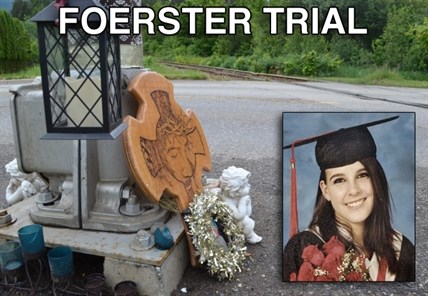
Friends and family created a memorial trail and tribute to Taylor Van Diest along the train tracks where her body was found.
Image Credit: Composite/ Jenn Stahn
April 01, 2014 - 1:01 PM
KELOWNA - The emergency doctor who treated a “gravely injured” Taylor Van Diest the night she was attacked by Matthew Foerster said he couldn’t have saved her life.
Michael Concannon, the Crown’s last witness, said it was a busy night at Vernon Jubilee Hospital the evening 18-year-old Van Diest was rushed into the trauma room. Paramedics had called ahead, and Concannon’s first assumption while awaiting for his patient was the young woman had been drinking, passed out, and may have been hit by a train. All he’d been told was she was found by the railway tracks in Armstrong. Van Diest’s injuries told a very different story.
“What I was faced with was a gravely injured young woman,” Concannon said.
While her Halloween zombie make-up made it a bit hard to tell where her actual injuries were, Concannon identified a serious skull fracture on her head and ligature marks around her neck. There was blood matted into the back of her hair, a gash on her eyebrow, hemorrhaging in her left eye, cuts on her lips. Her pupils were huge and barely responsive, he said.
Concannon set to work on Van Diest, who was unconscious and unable to breathe by herself. He remembers telling police officers in attendance Van Diest’s injuries did not look accidental. A CatScan showed “severe and devastating” brain injuries. Concannon said neither he, nor the emergency unit, would have been able to save her life given the extent of her injuries.
Earlier in the morning, court heard testimony from Const. Tyler Bell, one of the officers who interrogated Foerster in a video played in court. He also investigated the scene and collected evidence before Foerster’s arrest. The evening of Nov. 2 2011, two days after Van Diest was killed, Bell returned to the crime scene. He knew Van Diest’s last text message was sent shortly after 6 p.m. and wanted to see what the conditions were like at that time of day. At 6 p.m. he said it was beginning to get dark, and by 6:30 p.m. it was “fairly dark” along the corridor of the railway tracks. Because of dense vegetation along the track, he said the lighting had “diminished significantly” around the crime scene.
In cross examination, Foerster’s defense lawyer Lisa Jean Helps asked Bell if he was aware the police had requested records of Foerster’s financial transactions. Bell believed Royal Bank and Bank of Montreal records were obtained, but he didn’t recall looking through them. They weren’t particularly significant to his side of the investigation, he said.
Helps also questioned Bell about a Vernon liquor store called Gerry O’s. Bell said he was familiar with it, but when Helps asked if he had any reason to pull video surveillance from it, he said no. Her questions then turned to a Smirnoff vodka bottle found at the crime scene. Helps had the bottle taken out of evidence and shown to Bell, who confirmed he’d seized it as police evidence.
Supreme Court Justice Peter Rogers dismissed the jury for the afternoon session and told them to come back Thursday morning. The Crown’s case has concluded, and it remains unknown whether the defense will decide to call any evidence.
Foerster is being tried before a jury of five women and seven men. To prove first degree murder, the Crown must demonstrate Foerster’s actions were planned and deliberate, or that he killed her while sexually assaulting her.
To contact the reporter for this story, email Charlotte Helston at chelston@infotelnews.ca or call 250-309-5230. To contact the editor, email mjones@infotelnews.ca or call 250-718-2724.
LINKS:
FOERSTER TRIAL: Accused explains how he killed her - Infotel News
News from © iNFOnews, 2014